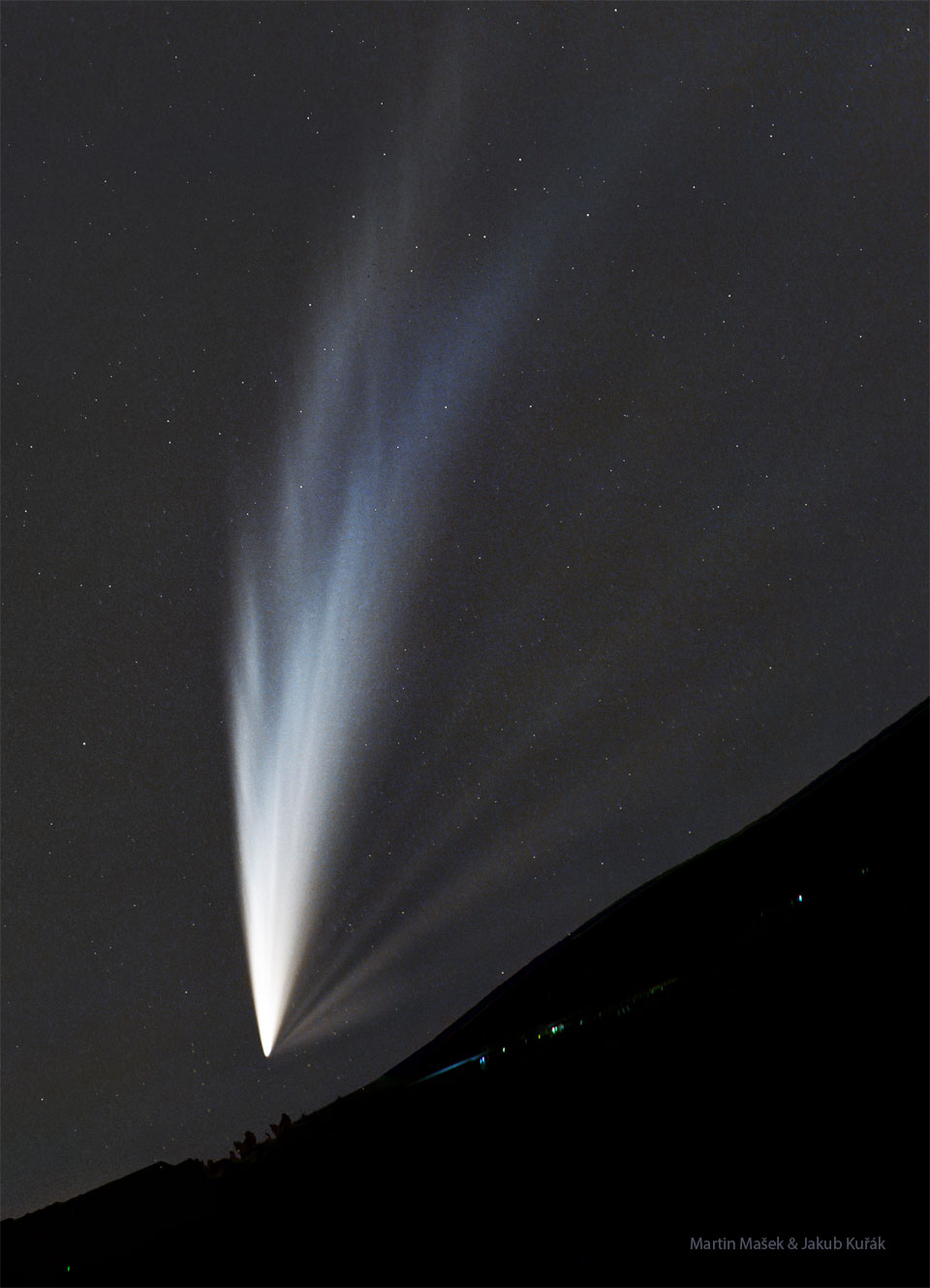Nombre total de pages vues
26/01/2025
AERONAUTIQUE - La grande épopée des ballons dirigeables - 2016 : la Natac de Voliris ou le drone version triple XL
SANTé*MEDECINE - A la découverte de l'oreille - L’implant cochléaire
ASTRONOMY - The Many Tails of Comet G3 ATLAS
2025 January 26
Image Credit & Copyright: Martin Mašek (FZU, Czech Academy of Sciences) & Jakub Kuřák
Explanation: Why does this comet have so many tails? C/2024 G3 (ATLAS) has developed several long and intricate tails visible from Earth's southern hemisphere over the past two weeks. Many observers reported seeing the impressive comet without any optical aid above the western horizon just after sunset. At least six different tails appear in the featured image captured five days ago from the dark skies above Paranal Observatory in Chile. One possible cause for the multiple tails is dust and gas being expelled from the comet's rotating nucleus. The outward push of the Sun's complex solar wind may also play a role. The huge iceberg-like nucleus of Comet ATLAS appears to have broken up near its closest approach to the Sun two weeks ago. Unfortunately, Comet ATLAS and its tails are expected to fade significantly over the coming weeks.
ASTRONOMY - Stardust in the Perseus Molecular Cloud
Image Credit & Copyright: Jeff Schilling
Explanation: Clouds of stardust drift through this deep skyscape, across the Perseus molecular cloud some 850 light-years away. Dusty nebulae reflecting light from embedded young stars stand out in the nearly 4 degree wide field of view. With a characteristic bluish color reflection nebula NGC 1333 is prominent near center. Hints of contrasting red emission from Herbig-Haro objects, the jets and shocked glowing gas emanating from recently formed stars, are scattered across the dusty expanse. While many stars are forming in the molecular cloud, most are obscured at visible wavelengths by the pervasive dust. The chaotic environment surrounding NGC 1333 may be similar to one in which our own Sun formed over 4.5 billion years ago. At the estimated distance of the Perseus molecular cloud, this cosmic scene would span about 80 light-years.
24/01/2025
SANTé/MEDECINE - A la découverte de l'oreille - La trompe d'Eustache
ASTRONOMY - Comet G3 ATLAS: a Tail and a Telescope
2025 January 24
Comet G3 ATLAS: a Tail and a Telescope
Explanation: Comet C/2024 G3 ATLAS has made a dramatic appearance in planet Earth's skies. A visitor from the distant Oort Cloud, the comet reached its perihelion on January 13. On January 19, the bright comet was captured here from ESO Paranal Observatory in the Atacama desert in Chile. Sporting spectacular sweeping dust tails, this comet ATLAS is setting in the southern hemisphere twilight and was clearly visible to the unaided eye. In the foreground is the closed shell of one of the observatory's famous auxiliary telescopes. Still wowing southern hemisphere observers, the comet's bright coma has become diffuse, its icy nucleus apparently disintegrating following its close approach to the Sun.
23/01/2025
SANTé/MEDECINE - A ladécouverte de l'oreille - Le neurinome de l’acoustique
ASTRONOMY - NGC 7814: Little Sombrero
2025 January 23
Image Credit & Copyright: Mike Selby
Explanation: Point your telescope toward the high flying constellation Pegasus and you can find this cosmic expanse of Milky Way stars and distant galaxies. NGC 7814 is centered in the sharp field of view that would almost be covered by a full moon. NGC 7814 is sometimes called the Little Sombrero for its resemblance to the brighter more famous M104, the Sombrero Galaxy. Both Sombrero and Little Sombrero are spiral galaxies seen edge-on, and both have extensive halos and central bulges cut by a thin disk with thinner dust lanes in silhouette. In fact, NGC 7814 is some 40 million light-years away and an estimated 60,000 light-years across. That actually makes the Little Sombrero about the same physical size as its better known namesake, appearing smaller and fainter only because it is farther away.
22/01/2025
SANTé/MEDECINE - A la découverte de l'oreille - Étrier droit - vue antérieure
ASTRONOMY - The North America Nebula
Image Credit & Copyright: Dimitris Valianos
Explanation: The North America nebula on the sky can do what the North America continent on Earth cannot -- form stars. Specifically, in analogy to the Earth-confined continent, the bright part that appears as the east coast is actually a hot bed of gas, dust, and newly formed stars known as the Cygnus Wall. The featured image shows the star forming wall lit and eroded by bright young stars and partly hidden by the dark dust they have created. The part of the North America nebula (NGC 7000) shown spans about 50 light years and lies about 1,500 light years away toward the constellation of the Swan (Cygnus).
LA TERRE VUE DU CIEL - New York vue de l'ISS
La ville de New York photographiée en 2010 depuis la Station spatiale internationale au cours de l'Expédition 24. © Fyodor Yurchikhin/R...

-
2022 September 26 All the Water on Planet Earth Illustration Credit: Jack Cook, Adam Nieman, Woods Hole Oceanographic Institution ; Data ...
-
2025 February 17 SpaceX Rocket Launch Plume over California Image Credit & Copyright: Martin LaMontagne Explanation: What's happe...









